

Computational Thinking with Scratch. Scratch crosscurricular integration guide. Pensamiento computacional. Pensamiento computacional. Competencias Estudiantiles del Tercer Milenio. 20/09/2011 at 8:32 am Antes de describir en detalle el programa para los estudiantes de 1ro a 3er grado es necesario hacer algunas observaciones respecto a estos cursos y sin duda la primera tiene que ver nuevamente con los horarios y es que con estos grupos se alternaron las clases con deporte lo cual no es un problema para el profesor de deporte, pero para el de computación si.

Cuando digo alternar, hago referencia a que en las dos horas de clase, los estudiantes se dividen en dos grupos, normalmente niños y niñas, la primera hora asiste los niños a computación y las niñas a deporta, la siguiente hora se intercambian los grupos. Se llegó a un acuerdo para alternar también, quienes van primero a deporte, evidentemente es más llamativo ir a deportes que a computación, sin embargo eso no es el problema. Programación en la Educación Escolar > Fundamentos > Artículos. Una guía de dibujos animados para solucionar problemas, diseñar sistemas y comprender el comportamiento humano.
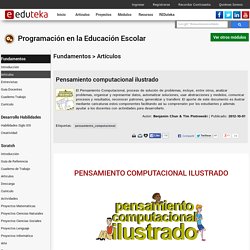
Front Page. Visual programming. Creative Computing. Ideas, approaches, and activities for cultivating computational thinking and computational creativity in your classroom Resources from a summer workshop for middle-school and high-school teachers Organized by the MIT Media Lab, in collaboration with Google's CS4HS initiative In this workshop for middle-school and high-school teachers, we explore new educational technologies and instructional strategies to engage students in creative design activities -- and, in the process, help students develop as computational thinkers and computational creators.
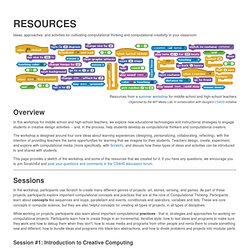
The workshop is designed around four core ideas about learning experiences (designing, personalizing, collaborating, reflecting), with the intention of providing teachers the same opportunities for learning that we imagine for their students. This page provides a sketch of the workshop and some of the resources that we created for it. Session #1: Introduction to Creative Computing Activities/Resources Session #2: Art. We are teaching london computing. National curriculum in England: computing programmes of study.
Purpose of study A high-quality computing education equips pupils to use computational thinking and creativity to understand and change the world.
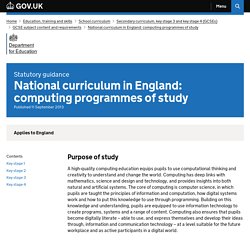
Computing has deep links with mathematics, science and design and technology, and provides insights into both natural and artificial systems. The core of computing is computer science, in which pupils are taught the principles of information and computation, how digital systems work and how to put this knowledge to use through programming. Building on this knowledge and understanding, pupils are equipped to use information technology to create programs, systems and a range of content. Computer Science Unplugged. Support for Teachers: Classroom Activities. The cs4fn team do a range of talks and activities.
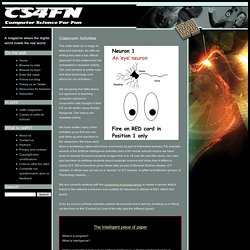
As with our writing they take a fun offbeat approach to the subject and are embedded in research activity. Xnergic Tecnocampus. Parte 1. Kindergarten coders can program before they can read - 26 July 2013. Going back to school to meet the 4-year-olds who are learning to program computers thanks to a new graphics-based coding language LORNA is 4, going on 5.

I've never met her before, but her eyes light up when she sees me. She rushes over, blonde curls bouncing. Kindergarten coders can program before they can read - 26 July 2013. Blockly - A visual programming editor. Blockly : Turtle Graphics. Python from Scratch - Tuts+ Code Tutorials. Py-scratch - Interface Python with MIT Scratch. This package enables communication between Python and Scratch using the remote sensors feature of Scratch.
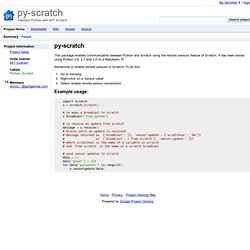
It has been tested using Python 2.6, 2,7 and 3.2 on a Raspberry Pi. Remember to enable remote sensors in Scratch! To do this: Go to Sensing Right-click on a 'sensor value' Select 'enable remote sensor connections' Robot Obstacle Course. Google Computer Science for High School. Google Computer Science for High School. Lifelong Kindergarten. KIWI - A robotics construction set for young children. Since 2007, through generous funding by the National Science Foundation (NSF Grant No.

DRL-1118897, DRL-0735657), the DevTech Research Group has been researching how to create a developmentally appropriate robotics construction set for young children in Pre-K through 2nd grade. The first prototype was called KIWI and consisted of intuitive, easy to connect construction materials including: wheels, motors, light output, and a variety of sensors (Sound, Light, and Distance sensors). KIWI is designed to work without any screentime using wooden programming blocks. The KIWI prototype paved the way to developing KIBO which is now commercially available through Kinderlab Robotics. ScratchJr - Imagine, Program, Learn. DevTech Research Group at Tufts University. DevTech Research Group at Tufts University. The effects of computer use on creative thinking among kindergarten children in Jordan. The objective of the current study was to examine the effect of early computer experience, using quasi-experimental design, on creative thinking among Jordanian kindergarten children.
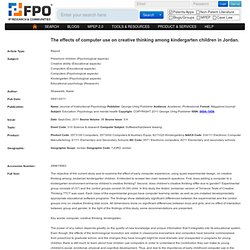
It intended to answer two main research questions. First, does adding a computer to a kindergarten environment enhance children's creative thinking? Second, does children's creative thinking differ due to gender? Experimental group consists of (37) and the control groups consist Of (39) child. In this study the Arabic Jordanian version of Torrance Tests of Creative Thinking TTCT was used.
CT-R2-v13 - Brennan_Resnick_AERA2012_CT.pdf. Designing ScratchJr: support for early childhood learning through computer programming - scratchjr_idc_2013.pdf. 5863P DESIGN MAKE PLAY-V/lb_Standard B 6x9 - designing-for-tinkerability.pdf. Chel Resnick Publications. Most Recent Book Resnick, M. (2017).
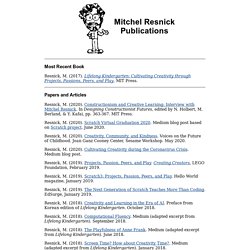
Lifelong Kindergarten: Cultivating Creativity through Projects, Passions, Peers, and Play. MIT Press. Institute for Mathematics and Computer Science. Unless you’ve been hiding under a rock for the past year, you’ll have noticed that the campaign to teach kids (and adults) how to code is everywhere you turn. As parents, politicians, and educators debate how to produce more graduates in technology fields, the push to introduce computing at an earlier age gets stronger. For example, MIT’s Lifelong Kindergarten group is collaborating on programming software aimed at kids in preschool to second grade. There are even board books for babies on HTML and CSS!
We suspect that such novelties are more for tech parents’ enjoyment. Ding and programming for Primary Schools: ComputerXplorers Middlesex. Everybody should learn how to program because it teaches you how to think... Steve Jobs ComputerXplorers is the market leader in teaching programming and coding to primary school children. Computational Thinking. The term 'Computational Thinking' has gained widespread currency.
Steve Hunt, from the School of Computer Science, University of Hertfordshire looks at what it means and why it is important. According to Computing: A Curriculum For Schools (March 2012), computational thinking is "...a mode of thought that goes well beyond software and hardware, and that provides a framework within which to reason about systems and problems. " But what does this mean in practice, and why is it so important? First let's look at what it's not. It is not thinking like a computer. CSTA. Search Resources: Español. Learn To Code, Code To Learn. Is it important for all children to learn how to write?
After all, very few children grow up to become journalists, novelists, or professional writers. So why should everyone learn to write? Of course, such questions seem silly. People use writing in all parts of their lives: to send birthday messages to friends, to jot down shopping lists, to record personal feelings in diaries. The act of writing also engages people in new ways of thinking. I see coding (computer programming) as an extension of writing. The recent surge of interest in learning to code, reflected in sites like codecademy.com and code.org, has focused especially on job and career opportunities. Espacio con experiencias didácticas con el uso de este entorno de programación creativo. Microsoft Word - AlgoritmosProgramacion_Ver21b.doc - AlgoritmosProgramacion.pdf. Aprender a programar, programar para aprender. Por Mitchel Resnick, PhD. Cuaderno de Trabajo para Programación con Scratch (4ta Edición) Programación en la Educación Escolar > Scratch > Regulación de Emociones.
Hoy en día se espera que los sistemas educativos preparen a los estudiantes para vivir y trabajar en armonía con los demás y para ser buenos ciudadanos en toda la extensión de la palabra. Sin embargo, volver realidad este propósito pasa necesariamente por que cada estudiante se conozca a sí mismo e identifique y aprenda a regular sus propias emociones.
Según J. Herramienta para analizar problemas. Investigación: Scratch y el desarrollo de habilidades de pensamiento. AnalisisProblemas_PLANTILLA.pdf. Scratch by dsigno. GUÍA DE REFERENCIA - SCRATCH versión 1 - ScratchGuiaReferencia.pdf. Download Kodu Game Lab from Official Microsoft Download Center. Programación en la Educación Escolar > Scratch > Recursos. GENERAR EJECUTABLES DE PROYECTOS SCRATCH Descargue ChirpCompiler (EXE, 2.6 MB) ChirpCompiler es una aplicación que permite crear un archivo ejecutable (.exe) de cualquier proyecto elaborado en Scratch sin necesidad de tener instalado en el computador el entorno de programación o de subir el proyecto a la página Web de Scratch ( Además, ofrece la posibilidad de distribuir fácilmente un proyecto desarrollado en Scratch mediante un archivo ejecutable (.exe), evitando de esta manera que quien lo recibe vea o modifique el código del proyecto.
Members & Content Tagged "ScratchMIT2012" Member since April 23, 2009 I am an Assistant Professor of Education at Harvard University, in the Graduate School of Education. My research is primarily concerned with the ways in which learning communities support computational creators -- and how technologies and environments can be designed for these learning communities. More concretely, my work focuses on young people's participation in the Scratch website and educators' experiences of working with Scratch in the classroom. As part of this work, I developed the ScratchEd online community, which was launched in August 2009. I completed my PhD at the MIT Media Lab, as a member of the Lifelong Kindergarten group, in October 2012. SCRATCH.